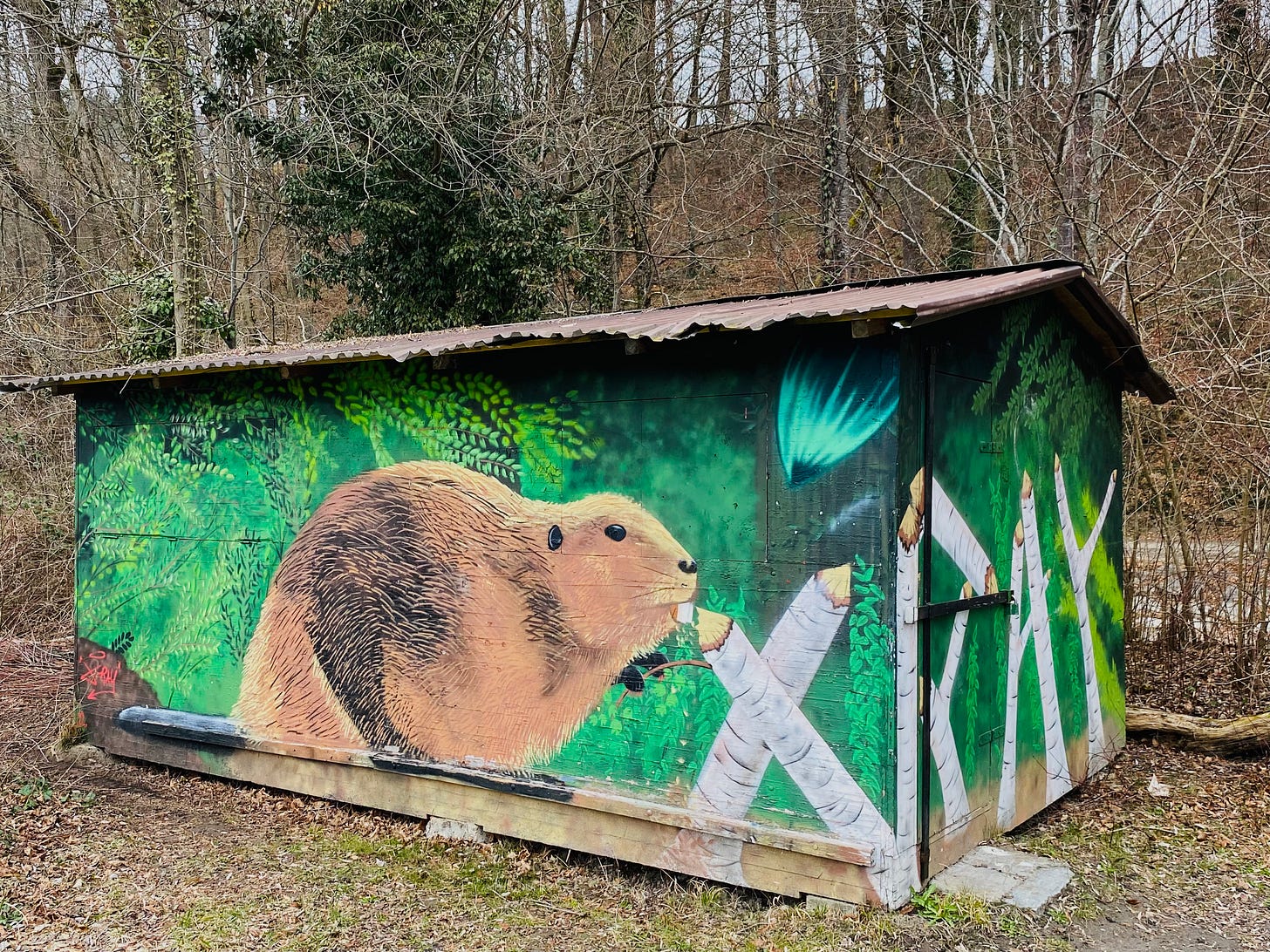Wait—beavers? What about otters? you may be asking. Otters are delightful animals, but they are mustelids, not rodents. We are talking about rodents this week.
Anyway . . .
A couple of months ago, the entire world was charmed by a story about some industrious Czech beavers who, in a matter of days, built a dam at the exact spot where officials had planned to build a dam but had not managed to break ground in seven years because of bureaucratic wrangling. The beavers saved Czechia more than a million euros in construction costs. (Can they come to the Twin Cities and finish up that section of 494 on the way to the airport, which has been under construction for seemingly decades?)
International Beaver Day1 was this past Monday (7 April). What a perfect opportunity to celebrate these wonderful animals!

A Digression on Permitting Reform
The Czech dam is by no means the only construction project awaiting a beaver colony to swim in and take charge. Our family lived in Prague for four years, and during that entire time a medium-sized house was being built down the street. Or, rather, half the house had been built, and then construction stalled because of red tape, and the house languished in limbo for the entire four years we lived there. As far as I know it sits there, unfinished, to this day.
After our family took a trip to Istanbul, I started to joke that that house had been put to shame by the Hagia Sophia. The Hagia Sophia was the largest religious building in the world for a thousand years. It had been built by hand in only five years, from 532–537CE, and was so well-constructed that it survived two earthquakes before a third caused the dome to collapse. A new dome was built, and the Hagia Sophia presides over the center of Istanbul to this day.
What did the Byzantines know that we don’t?
Of course it is good that we have better labor practices nowadays than those that prevailed in Justinian’s time. But with our modern technology and know-how, we could be building far more—and far more quickly—and still protect workers. It is difficult to overstate how maddening the bureaucratic obstacles to even small improvements can be. For example, Zach Klein, the co-founder of Vimeo, became frustrated after witnessing several crashes in front of his house. He requested that San Francisco install a speed bump and duly completed the paperwork, only to be informed that it would take the city two years just to process it. So he bought his own speed bump on the internet. As the journalists Ezra Klein2 and Derek Thompson argue in their excellent new book, Abundance, we need to clear away these senseless obstacles so that we can build the housing and infrastructure we so desperately need.
I think we love the story of the Czech beavers because they simply took care of business. They saw a problem and fixed it, with no need for lengthy comment periods when any Tom, Dick, or Harry could raise a minor objection and call a halt to progress;3 no requirement that permits be obtained from multiple offices, each with its own byzantine rules; and no demand that extraneous, expensive goals be attached to every project.
It can be done! When the I-95 bridge in Philadelphia collapsed, Pennsylvania Governor Josh Shapiro rebuilt it in twelve days. Not twelve (or twenty-four) months, as had been predicted, but twelve days. How is this possible? As Klein and Thompson inform us, Shapiro
signed a declaration of emergency that exempted the rebuilding process from the rules and requirements that slow so many public projects down. … There would be no environmental impact statement. There would be no lengthy bidding process. The procurement rules were shunted aside.
. . .
The emergency declaration allowed Shapiro to make choices. He chose to use union labor but to gore a lot of other interests and processes. … His popularity swelled. … Turns out people like it when their government gets things done.4
The Inspiring Tale of the Bern Beavers
The Bern zoo has a section that sits right on the Aare River, which houses otters, pelicans, and, formerly, beavers. In 1999, a “hundred-year flood” swept through and swamped the zoo’s ponds, and the beavers seized the opportunity to swim out of their enclosures and into freedom. Ever since that day, the beavers have been a crucial part of the river’s ecosystem. They established an extensive wetland alongside the river, which has become a habitat for waterfowl and small mammals. The beavers also cull the trees and help to purify and maintain the groundwater we all drink.
Beavers are endangered in Switzerland, but thanks to the initiative of these long-ago zoo beavers, they have bounced back, and populations have tripled since the last beaver census fifteen years ago. Like the Czech beavers, our Swiss beavers didn’t wait for humans to solve their problems. The beavers who swam to freedom more than a quarter-century ago founded the largest beaver colony in Switzerland along the Aare right below our house. While I have not yet seen a wild Bern beaver in person, I enjoy seeing evidence of their handiwork (toothiwork?) on my daily walks:
Bern’s citizens love the beavers and pay them artistic homage, for example on the side of this shed on a small island in the river:
Fun Beaver Facts
MIT’s mascot is the beaver—appropriately, given that beavers are nature’s engineers.

Beavers don’t usually kill trees. Their preferred trees—aspens, willows, and poplars—have evolved in tandem with beavers and “are able to re-sprout readily in response to beavers cutting them down.”
Beavers’ teeth are orange because of iron in the enamel. The iron makes their teeth strong enough to gnaw through trees. Beaver teeth are special for another reason: “Because the softer dentine (bony tissue that forms a tooth) wears away faster than the enamel, a beaver’s teeth wear down unevenly. This gives the incisors a chiseled shape, which helps beavers cut through hard objects like wood.”
Beavers’ front teeth never stop growing. If not worn down by constant gnawing, their incisors would grow an average of six feet every decade! The growth rate slows in late summer and early autumn, so scientists can count the stripes in fossilized beaver teeth the same way they count tree rings.
Beavers purify our water. “Dammed streams create ponds which can trap sediment … and trap, process, and remove” phosphorus. Their dams also prevent excessive runoff, which helps restore groundwater levels. A study published in 2021 in Mammal Review estimates that beavers provide more than $200 million worth of infrastructure assistance per year to humans.
I recently learned, to my shock and amazement, that, to paraphrase that meme about the size of animals, beavers are much, MUCH bigger than you think. The average beaver weighs 16–30kg (35–65lbs), but because they continue to grow for their entire lives, older beavers are enormous. The largest beaver ever measured weighed in at a hefty 50kg (110lbs). Imagine a really big Golden Retriever. That’s how big a beaver can get!
And finally, did you know this? I didn’t!
But Who Will Speak for the Capybaras?
My friend’s terrific daughter Silvie was the Happy Wanderer Special Guest Star a couple of weeks ago. In addition to being an ace cartoon analyzer, Silvie is au courant on Zoomer preferences and informs me that everyone’s favorite rodent is not actually the beaver. It is the capybara. Could this be because, as Gary Shteyngart put it in his recent New Yorker article,
the capybara represented a duality I knew all too well: a desperately friendly creature always afraid of being attacked. Is this why people love the capybara? Do we all feel trapped in a world that encourages us to be hyper-social yet rewards us with nothing but endless existential anxiety?
Well, that’s a relatable but kind of bleak view of the capybara—and of us.
I prefer the following story, from a letter by Christine Sharp, in the New Yorker’s March 3, 2025 issue,5 about a couple of wonderfully intrepid capybaras—escape artists worthy of Bern’s beavers:
In May, 2016, two capybaras escaped from Toronto’s High Park Zoo; dubbed Bonnie and Clyde, they spent several weeks on the lam in High Park, sometimes frolicking within plain sight while eluding capture. … Months later, back at the zoo … Bonnie and Clyde became parent to three “capybabies.” … Tens of thousands of Canadians participated in a contest to name them, resulting in Alex, Geddy, and Neil, after the members of the beloved Canadian rock band Rush.
In honor of beavers, capybaras, and all creatures who seek freedom from harmful constraints, let’s hear from the original Alex, Geddy, and Neil:
How about you, readers? Are you a fan of beavers (or capybaras)? Or do you have another favorite rodent? Please share your thoughts in the comments!
The Tidbit
What’s even cuter than a beaver? A baby beaver!
Did you know there was such a thing as International Beaver Day? Me neither.
Are Zach Klein and Ezra Klein brothers? A cursory internet search turns up bupkis. But if they are related, that is a lot of talent in one family!
How minor can these objections get? In a podcast interview with Yoni Applebaum, Thompson tells of a much-needed affordable housing project that was blocked because, among other reasons, a woman testified at a hearing that she owned a diabetic horse, and she feared that if the housing was built, passers-by might feed her horse apples and kill him:
The Board of Supervisors is choosing to care about this woman and choosing to care about … her type 2 diabetic horse, who could theoretically be fed apples by a stranger. …
But that’s because she is the person they can see. They can’t see the 50 people who would be able to live in that apartment development, who are not present at that supervisor’s meeting.
Ezra Klein and Derek Thompson, Abundance (New York: Simon and Schuster, 2025), pp. 125, 126.
As far as I can tell, the New Yorker doesn’t publish reader letters in their online edition. I get the physical copy, which is where I saw this letter.







So funny that you posted this today. I got into the car to drive to work this morning and the podcast Oligies started playing "Castorology (Beavers) with Rob Rich." I am about half way through - I am learning some very interesting facts about beavers. I recommend the episode.
Mari, have you seen the film "Hundreds of Beavers?" One of the best cinematic experiences I've had in a long time. (Although, the beavers are not the heroes of that film, to put it mildly!)